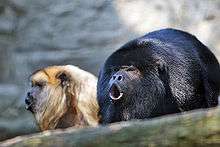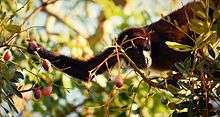Howler monkey
| Howler monkey[1] | |
|---|---|
 | |
| Brown howler | |
| Scientific classification | |
| Kingdom: | Animalia |
| Phylum: | Chordata |
| Class: | Mammalia |
| Order: | Primates |
| Family: | Atelidae |
| Subfamily: | Alouattinae Trouessart, 1897 (1825) |
| Genus: | Alouatta Lacepede, 1799 |
| Type species | |
| Simia belzebul Linnaeus, 1766 | |
| Species | |
|
Alouatta arctoidea | |
 | |
| Howler monkeys distribution | |
| Synonyms | |
|
Mycetes Illiger, 1811 | |
Howler monkeys (genus Alouatta monotypic in subfamily Alouattinae) are among the largest of the New World monkeys and one of only a few nest-building monkeys. Fifteen species are currently recognised. Previously classified in the family Cebidae, they are now placed in the family Atelidae. These monkeys are native to South and Central American forests. Threats to howler monkeys include human predation, habitat destruction and being captured for captivity as pets or zoo animals. These monkeys are famous for their loud howls, which can travel three miles through dense rainforest.
Classification
- A. palliata group
- Coiba Island howler, Alouatta coibensis
- Alouatta coibensis coibensis
- Azuero howler, Alouatta coibensis trabeata
- Mantled howler, Alouatta palliata
- Ecuadorian mantled howler, Alouatta palliata aequatorialis
- Golden-mantled howler, Alouatta palliata palliata
- Mexican howler monkey, Alouatta palliata mexicana
- Guatemalan black howler, Alouatta pigra
- Coiba Island howler, Alouatta coibensis
- A. seniculus group
- Ursine howler, Alouatta arctoidea
- Red-handed howler, Alouatta belzebul
- Spix's red-handed howler, Alouatta discolor
- Brown howler, Alouatta guariba
- Northern brown howler, Alouatta guariba guariba
- Southern brown howler, Alouatta guariba clamitans
- Juruá red howler, Alouatta juara
- Guyanan red howler, Alouatta macconnelli
- Amazon black howler, Alouatta nigerrima
- Purus red howler, Alouatta puruensis
- Bolivian red howler, Alouatta sara
- Venezuelan red howler, Alouatta seniculus
- Maranhão red-handed howler, Alouatta ululata
- A. caraya group
- Black howler, Alouatta caraya
Anatomy and physiology

Howler monkeys have short snouts and wide-set, round nostrils. Their noses are very keen, and the howler monkey can smell out its food (primarily fruit and nuts) up to 2 km away. Their noses are usually roundish snout-type, and the nostrils have many sensory hairs growing from the interior. They range in size from 56 to 92 cm (22 to 36 in), excluding their tails, which can be equally as long, in fact in some cases the tail has been found to be almost 5 times the body length. This is a prime characteristic. Like many New World monkeys, they have prehensile tails, which they use for picking fruit and nuts from trees. Unlike other New World monkeys, both male and female howler monkeys have trichromatic color vision.[2] This has evolved independently from other New World monkeys due to gene duplication.[3] They have lifespans of 15 to 20 years. Howler species are dimorphic and can also be dichromatic (i.e. Alouatta caraya). Males are, on average, 1.5 to 2.0 kg heavier than females.
The hyoid of Alouatta is pneumatized, one of the few cases of postcranial pneumaticity outside Saurischia. The volume of the hyoid of male howler monkeys is negatively correlated with the dimensions of their testes.[4]
Locomotion
Howler monkeys generally move quadrupedally on the tops of branches, usually grasping a branch with at least two hands or one hand and the tail at all times. Their strong prehensile tails are able to support their entire body weight. Fully grown adult howler monkeys do not often rely on their tails for full body support, whereas juveniles do so more frequently.
Behavior
.jpg)
Social systems
Most howler species live in groups of 6 to 15 animals, with one to three adult males and multiple females. Mantled howler monkeys are an exception, commonly living in groups of 15 to 20 individuals with more than three adult males. The number of males in a given group is negatively correlated with the size of their hyoid, and is positively correlated with testes size. This results in two distinct groups, wherein there is one male, who has a larger hyoid, and smaller testes, who copulates exclusively with a group of females. The other group has more males, who have smaller hyoids, and larger testes, and there is free copulation among the group. The larger the number of males, the smaller the hyoid, and the larger the testes.[4] Unlike most New World monkeys, in which one sex remains in natal groups, juveniles of both sexes emigrate from their natal groups,[5] such that howler monkeys could spend the majority of their adult lives in association with unrelated monkeys.
Physical fighting among group members is infrequent and generally of short duration. However, serious injuries can result. Both males and females rarely fight with each other, but physical aggression is even more rare between sexes.[5][6] Group size varies by species and by location, with an approximate male to female ratio of one male to four females.[5]
Communication

![]() As their name suggests, vocal communication forms an important part of their social behavior. They each have an enlarged basihyal or hyoid bone which helps them make their loud vocalizations. Group males generally call at dawn and dusk, as well as interspersed times throughout the day. The main vocals consist of loud, deep guttural growls or "howls". Howler monkeys are widely considered to be the loudest land animal. According to Guinness Book of World Records, their vocalizations can be heard clearly for 3 mi (4.8 km).[7] The function of howling is thought to relate to intergroup spacing and territory protection, as well as possibly to mate-guarding.
As their name suggests, vocal communication forms an important part of their social behavior. They each have an enlarged basihyal or hyoid bone which helps them make their loud vocalizations. Group males generally call at dawn and dusk, as well as interspersed times throughout the day. The main vocals consist of loud, deep guttural growls or "howls". Howler monkeys are widely considered to be the loudest land animal. According to Guinness Book of World Records, their vocalizations can be heard clearly for 3 mi (4.8 km).[7] The function of howling is thought to relate to intergroup spacing and territory protection, as well as possibly to mate-guarding.
Diet and feeding

These large and slow-moving monkeys are the only folivores of the New World monkeys. Howlers eat mainly top canopy leaves, together with fruit, buds, flowers, and nuts. They need to be careful not to eat too many leaves of certain species in one sitting, as some contain toxins that can poison them.[8] Howler monkeys are also known to occasionally raid birds' nests and chicken coops and consume the eggs.[9]
Relationship with humans
While seldom aggressive, howler monkeys do not take well to captivity and are of surly disposition. However, the black howler (Alouatta caraya) is a relatively common pet monkey in contemporary Argentina due to its gentle nature, in comparison to the capuchin monkey's aggressive tendencies, in spite of its lesser intelligence, as well as the liabilities meant by the size of its droppings and the males' loud vocalisations.
John Lloyd Stephens described the howler monkeys at the Maya ruins of Copán as "grave and solemn, almost emotionally wounded, as if officiating as the guardians of consecrated ground". To the Mayas of the Classic Period, they were the divine patrons of the artisans, especially scribes and sculptors. They were seen as gods in some tribes, and the long, sleek tail was worshipped for its beauty. Copán in particular is famous for its representations of howler monkey gods. Two howler monkey brothers play a role in the myth of the Maya Hero Twins included in the Popol Vuh, a widely feared tale of soul and passion.
References
- ↑ Groves, C.P. (2005). Wilson, D.E.; Reeder, D.M., eds. Mammal Species of the World: A Taxonomic and Geographic Reference (3rd ed.). Baltimore: Johns Hopkins University Press. pp. 148–152. OCLC 62265494. ISBN 0-801-88221-4.
- ↑ Jacobs, G. H.; Neitz, M.; Deegan, J. F.; Neitz, J. (1996). "Trichromatic colour vision in New World monkeys". Nature. 382 (6587): 156–158. doi:10.1038/382156a0. PMID 8700203.
- ↑ Lucas, P. W.; N. J. Dominy (2003). "Evolution and function of routine trichromatic vision in primates". Evolution. 57 (11): 2636–43. doi:10.1554/03-168. PMID 14686538.
- 1 2 Dunn, J. C.; Halenar, L. B.; Davies, T. G.; Cristobal-Azkarate, J.; Reby, D.; Sykes, D.; Dengg, S.; Fitch, W. T.; Knapp, L. A. (2015). "Evolutionary Trade-Off between Vocal Tract and Testes Dimensions in Howler Monkeys". Current Biology. 25 (21): 2839–44. doi:10.1016/j.cub.2015.09.029.
- 1 2 3 Sussman, R. (July 2003). Primate Ecology and Social Structure, Vol. 2: New World Monkeys, Revised First Edition. Pearson Prentice Hall. pp. 142–145. ISBN 0-536-74364-9.
- ↑ Crockett (1997-10-02). "Family Feuds". In Ciochon, R. L.; Nisbett, R. A. Primate Anthology, The: Essays on Primate Behavior, Ecology and Conservation from Natural History. Prentice Hall. p. 32. ISBN 978-0-13-613845-7.
- ↑ http://nationalzoo.si.edu/animals/smallmammals/exhibits/howlermonkeys/loudestanimal/default.cfm
- ↑ Glander, Kenneth E. (March 1977). "Poison in a monkey's Garden of Eden". Natural history. 86: 146–151.
- ↑ , additional text.
External links
| Wikispecies has information related to: Alouattinae |
| Wikispecies has information related to: Alouatta |
| Wikimedia Commons has media related to howler monkeys. |
- Primate Info Net Alouatta Factsheets
- Howler monkey audio recording
- Information about howler monkeys from Belize Zoo (photos, video and audio included)
- "The Loudest Animal in the New World," Smithsonian National Zoological Park
_2.jpg)